
 Because she is Australia's first saint, Mary of the Cross MacKillop has taken most of the headlines about today's canonization and the lion's share of the reportage in the the Anglophone media. Even if another new saint, Andre Bessette, is also from an Anglophone country, Canada, he was French Canadian.
Pope Benedict canonizes first
Because she is Australia's first saint, Mary of the Cross MacKillop has taken most of the headlines about today's canonization and the lion's share of the reportage in the the Anglophone media. Even if another new saint, Andre Bessette, is also from an Anglophone country, Canada, he was French Canadian.
Pope Benedict canonizes first
Australian saint and 5 others
By Nicole Winfield


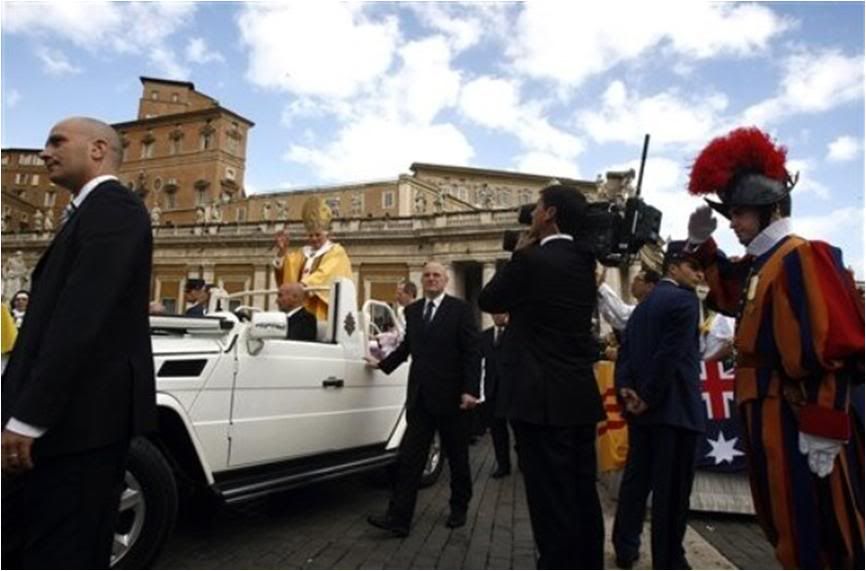
VATICAN CITY, Oct. 17 (AP) - Pope Benedict XVI proclaimed Australia's first saint on Sunday, canonizing a 19th-century nun and also declaring five other saints in an open-air Mass attended by tens of thousands.
Chants of "Aussie Aussie Aussie! Oi Oi Oi!" echoed throughout St. Peter's Square as a raucous crowd of flag-and-balloon-carrying Australians used a traditional sports cheer to celebrate the honor bestowed on their late native, Mary MacKillop. In Sydney, huge images of the nun were projected onto the sandstone pylons of the iconic Sydney Harbor Bridge.
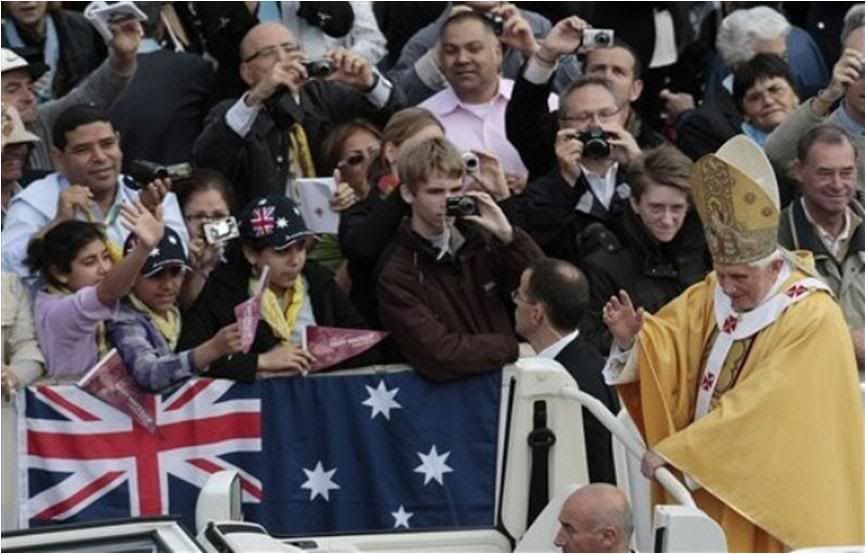
Speaking in Latin on the steps of St. Peter's Basilica, Benedict solemnly read out the names of each of the six new saints, declaring each one worthy of veneration in all the Catholic Church. Among them was Brother Andre Bessette, a Canadian brother known as a "miracle worker" and revered by millions of Canadians and Americans for healing thousands of sick who came to him.
"Let us be drawn by these shining examples, let us be guided by their teachings," Benedict said in his homily, delivered in English, French, Italian, Polish and Spanish to reflect the languages spoken by the church's newest saints.
A cheer had broken out in the crowd when MacKillop's name was announced earlier in the Mass, evidence of the significant turnout of Australians celebrating the humble nun who was excommunicated for a few months
in part because her religious order exposed a pedophile priest. [Unfortunately, we now have to live with this egregious example of media revisionism to serve their anti-Church agenda. First started a few weeks ago and since protested by St. mary's postulator and biogrpaher, MSM has nonetheless embraced it as a 'fact' and has ceaselessly perpetrated it since then!]
Even more MacKillop admirers -- an estimated 10,000 -- converged Sunday at the Sydney chapel where she is buried and at Sydney's Catholic cathedral, where a wooden cross made from floorboards taken from the first school that MacKillop established was placed on the steps.
Thousands of other Australians spent Sunday evening watching live broadcasts of the Vatican ceremony on television at home or on large outdoor screens in Sydney, in Melbourne where she was born, as well as in Penola, where MacKillop established her first school.
Born in 1842, MacKillop grew up in poverty as the first of eight children of Scottish immigrants. She moved to the sleepy farming town of Penola in southern Australia to become a teacher, inviting the poor and local Aborigines to attend free classes in a six-room stable.
She co-founded her order, the Congregation of the Sisters of St. Joseph of the Sacred Heart, with the goal of serving the poor, the sick and the disadvantaged, particularly through education.
"She supported Aboriginal people because she believed in supporting people who were disadvantaged," said Melissa Brickell, a pilgrim from Melbourne who was in St. Peter's Square for the ceremony. "She is a friend of Aboriginal people from the early days."
As a young nun in 1871, MacKillop and 47 other nuns from her order were briefly dismissed from the Roman Catholic Church in a clash with high clergy. In addition to bitter rivalries among priests,
one of the catalysts for the move was that her order had exposed a pedophile priest.
Five months later, the bishop revoked his ruling from his deathbed, restoring MacKillop to her order and paving the way for her decades of work educating the poor across Australia and New Zealand.
In his homily, Benedict praised MacKillop for her "courageous and saintly example of zeal, perseverance and prayer."
"She dedicated herself as a young woman to the education of the poor in the difficult and demanding terrain of rural Australia, inspiring other women to join her in the first women's community of religious sisters of that country," Benedict said in English.
MacKillop became eligible for sainthood after the Vatican approved a second miracle attributed to her intercession, that of Kathleen Evans, who was cured of lung and brain cancer in 1993.
In a statement Sunday, Evans said she was humbled by MacKillop's example, grateful for her healing and overjoyed that MacKillop will now be more widely known.
"I think she would be delighted to see so many people looking at their own lives and considering how they can live better and care more," said Evans, who brought relics of MacKillop up to the altar during the canonization Mass.
Veronica Hopson, 72, was MacKillop's first miracle, cured of leukemia in 1961. She broke half a century of silence about her case, telling Australia's Channel Seven's Sunday Night program: "How does a miracle feel? I feel very fortunate that I was given the opportunity to live my life, have a family, have grandchildren, so that's a miracle."
Hopson was 22 when she was diagnosed with leukemia and given only weeks to live. She said her mother contacted nuns at Saint Joseph's convent in northern Sydney where Hopson was taught as a schoolgirl and where MacKillop once lived. The nuns brought cloth that MacKillop had worn and prayed for Hopson.
Hopson, who went on to have six children and four grandchildren, is recovering from recent bowel cancer. She said her miracle also carried a message for people who did not believe in God.
"I guess they must have some sort of hope, not just give in and just let the illness or sad things that happen in their life take over their life. Just keep hoping that it will get better," she said.
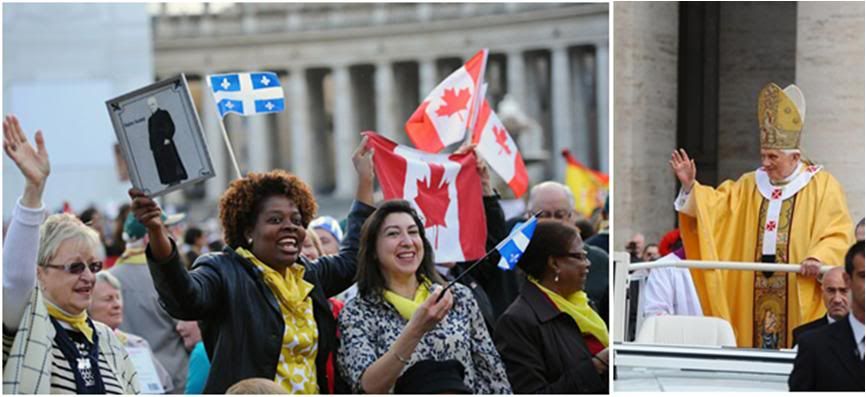
Canada's maple-leaf flag and Quebec's blue-and-white, fleur-de-lis flag was also out in force in St. Peter's Square in support of Brother Andre, a Canadian who legend says healed thousands of sick who prayed with him at his Montreal oratory.
Born in 1845, Brother Andre was orphaned at the age of 12. After taking his religious vows, he devoted his life to helping others and gained a reputation as a healer. When he died in 1937 at the age of 91, an estimated 1 million people came to pay homage.
"I think all the people from Quebec are happy now," said Alain Pilote, a 49-year-old pilgrim from Rougemont, near Montreal, who came to Rome for the Mass.
Benedict noted that Brother Andre was poorly educated but nevertheless understood what was essential to his faith.
"Doorman at the Notre Dame College in Montreal, he showed boundless charity and did everything possible to soothe the despair of those who confided in him," Benedict said in French.
Francoise Bessette, whose grandfather was Brother Andre's first cousin, was among the Canadians in attendance Sunday at St. Peter's.
"I didn't think this would happen while I was alive," said Bessette, whose brother Andre was named after the saint. "So to be here today is very special for me."
Australia's foreign minister, Kevin Rudd, was in Rome for the canonization, as was Canada's foreign minister, Lawrence Cannon. The Polish president, Bronislaw Komorowski, joined thousands of Polish pilgrims to honor that country's latest saint, Stanislaw Kazimiercyzk.
Also being canonized Sunday were Italian nuns Giulia Salzano and Battista Camilla da Varano, and Spanish nun Candida Maria de Jesus Cipitria.
 Pope Benedict XVI
Pope Benedict XVI
canonizes six new saints

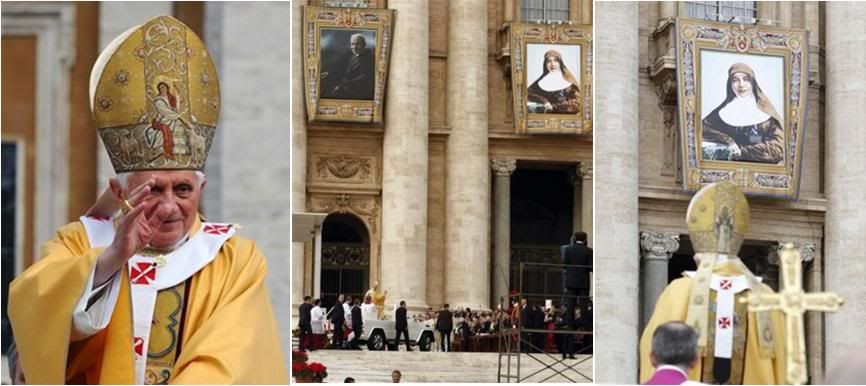
VATICAN CITY, Oct. 17 (AFP) – Pope Benedict XVI formally recognised Australia's first saint, Mary MacKillop, at a mass in Saint Peter's Square in the Vatican on Sunday in front of some 50,000 cheering pilgrims.
Speaking in Latin, the Pope also canonised Canada's Brother Andre Bessette and four other saints from Italy, Poland and Spain, declaring that "throughout the Church they be honoured devoutly among all the saints."
Some 6,000 Australians came for the ceremony, Vatican authorities said, many wearing Australian bush hats and waving Australian flags.
"It's just wonderful. We've always believed Mary was a saint," said Moya Campbell, one of 800 nuns in the crowd from the Sisters of Saint Joseph of the Sacred Heart, the order that MacKillop helped found.
"This is awesome," said Emilia Mourani, 36, who flew in from Sydney.
"I've prayed to her and she's helped me with my problems. That's why I'm here, I wanted to thank her," she said, visibly moved by the moment.
Rudd earlier paid tribute to MacKillop as "an extraordinary Australian."
Anna Diliddo, 45, an art teacher from Toronto, came with a school group of 18 pupils and six teachers to witness the canonisation of Brother Andre.
"I feel very excited. He was wonderful. He healed many," Diliddo said.
There were nationwide celebrations in Australia for MacKillop (1842-1909) and her canonisation was preceded by a series of events in Rome including an open-air Aboriginal show at the Vatican museum with didgeridoo music.
MacKillop was an inspirational nun and teacher who fell out with Australian church authorities and was briefly excommunicated in 1871 in a fight over control of her order and
after her denunciation of a paedophile priest.
[There is that myth now reiterated as 'fact'!]
"St Mary's canoniation highlights the central role Christian faith has played in Australian history," Cardinal George Pell, the archbishop of Sydney, who helped celebrate the Mass, wrote in Australia's
Sunday Telegraph.
"Mary -- Saint Mary of the Cross -- was a fine Australian and an outstanding Catholic," Pell said, referring also to the "unprincipled opposition opposition from bishops, clergy and even her own sisters" that she encountered.
Also among the spectators was Father Thomas Casanova, 43, a Catholic priest from Wagga Wagga in New South Wales.
"It's a momentous occasion. I've been looking forward to this since I was a child," said Casanova -- a distant relative of the new saint.
"She will help us have a greater perspective on life," he said.
A part-religious, part-nationalist, part-media frenzy has seized Australia for the canonisation, with "MacKillop" the musical playing to sold-out shows and a nightly projection of her image on the Sydney Harbour Bridge.
MacKillop already has stamps and pop songs in her honour, along with merchandise including bumper stickers and keyrings that is selling briskly. Her fans have also set up a Facebook page and a Twitter account in her honour.
Canonisation is only the end point of a long process of documentation and research into the life of would-be saints by Vatican authorities that often lasts several years and must include at least two proven miracles.
Brother Andre (1845-1937), a
monk [He was not a monk!] from the Canadian province of Quebec was credited with healing powers that were initially dismissed by senior clergy.
The six saints announced on Sunday bring to 34 the number of people canonised by Benedict XVI since his election to the papacy in 2005. His predecessor John Paul II, recognised almost 500 saints.
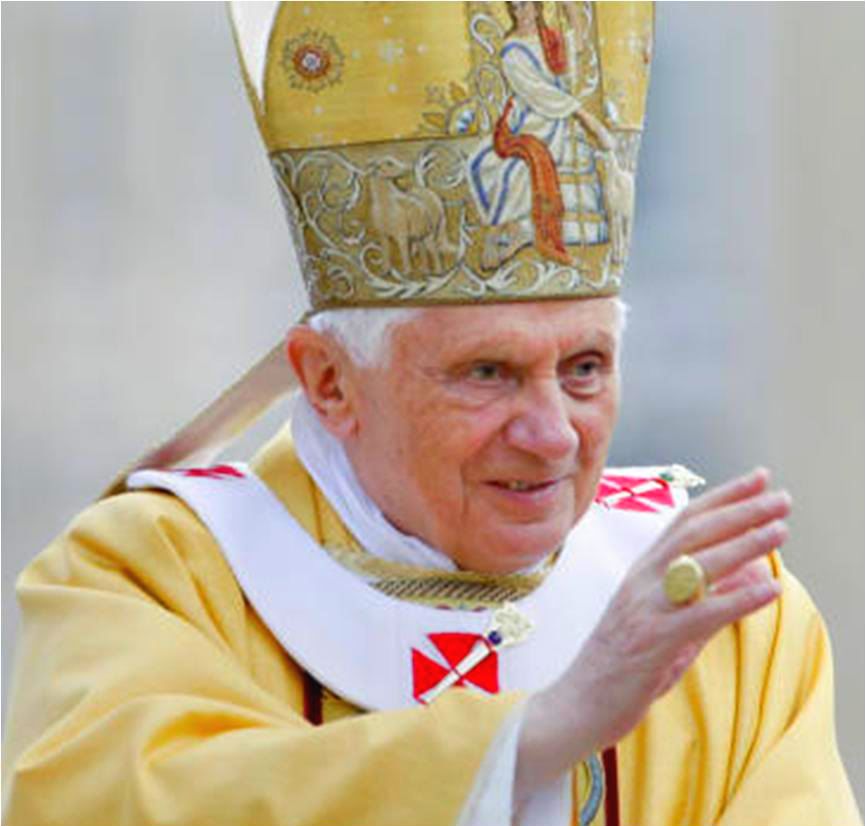

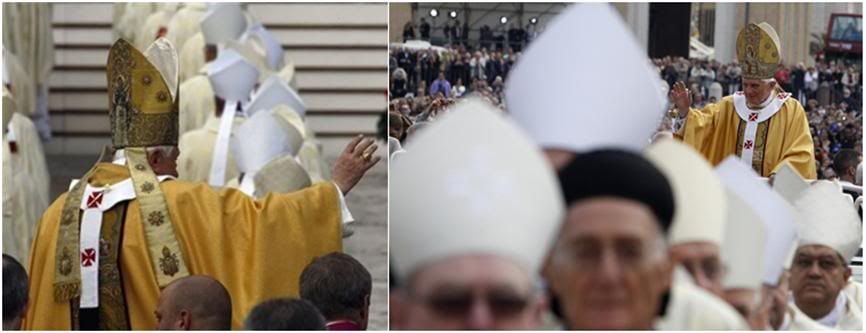

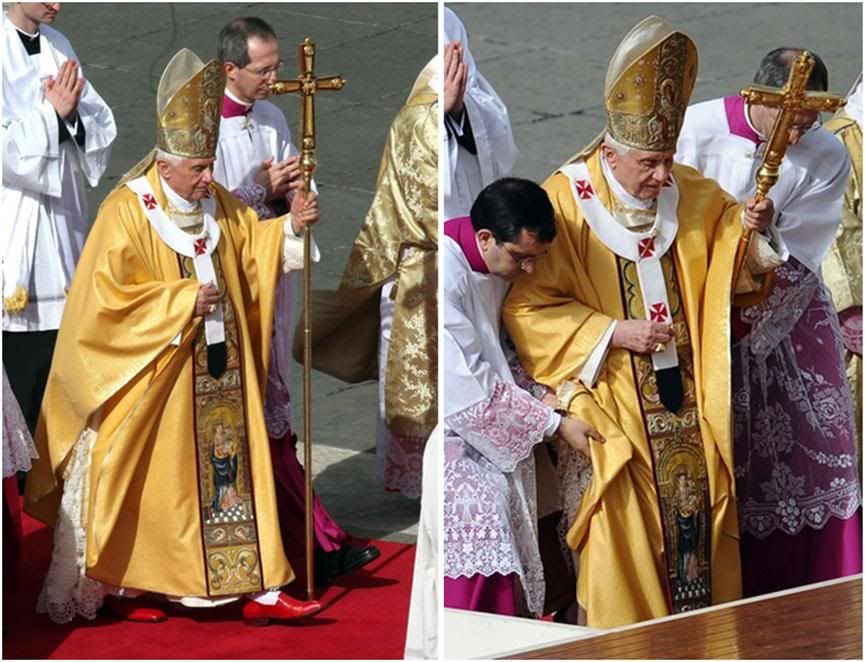
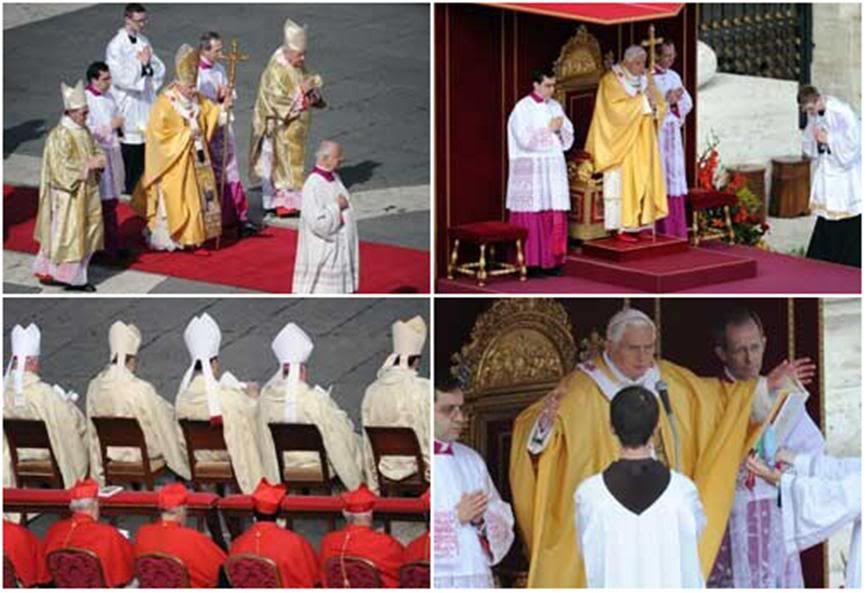

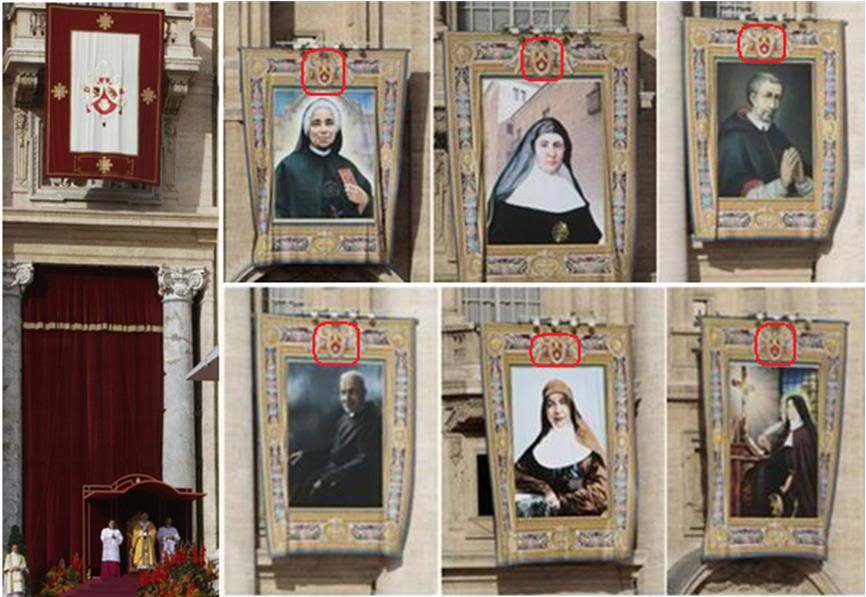 The familiar coat of arms was not only hanging from the central loggia of St. Peter's today - it was also woven into the top of the tapestries depicting the six new saints to indicate they were canonized by this Pope.
And here's a report from Canadian TV to 'make up' in part for the Anglophone focus on St. Mary of the Cross:
Brother Andre is declared a saint
The familiar coat of arms was not only hanging from the central loggia of St. Peter's today - it was also woven into the top of the tapestries depicting the six new saints to indicate they were canonized by this Pope.
And here's a report from Canadian TV to 'make up' in part for the Anglophone focus on St. Mary of the Cross:
Brother Andre is declared a saint
by the News Staff

Oct. 17, 2010
The humble Quebec monk who founded Montreal's St. Joseph's Oratory was named a saint by Pope Benedict in a ceremony at the Vatican Sunday.
The former Brother Andre, who was credited with miracle healings before his death in 1937, is now St. Andre.
The Pope told the thousands of faithful gathered for the ceremony, including hundreds of Canadians, that although St. Andre was poorly educated and working at a menial job, he was an inspiration to many faithful.
"(As) doorman at the Notre Dame College in Montreal, he showed boundless charity and did everything possible to soothe the despair of those who confided in him," Benedict said.
Foreign Affairs Minister Lawrence Cannon led the official Canadian delegation to the ceremony.
"Here is a person who throughout his life had a dream, and he was able to pursue that dream, he was able to build the St. Joseph Oratory in Montreal," Cannon told CTV News Channel on Sunday in a telephone interview from Rome.
"So I think that when one looks at him, and what he was able to do throughout his life, he will be an inspiration for generations of Canadians to come."
Francoise Bessette, whose grandfather was Brother Andre's first cousin, was among the thousands of Canadians in attendance.
"I didn't think this would happen while I was alive," said Bessette, whose brother was named after the saint. "So to be here today is very special for me."

In Montreal, the faithful crowded around a big-screen television in the Oratory's church to watch the ceremony broadcast live from St. Peter's Square.
His elevation to sainthood will carry some worldly benefits for St. Andre's hometown, according to Kevin Wright, the president of the U.S.-based world religious travel association.
"When an individual is declared a saint, their shrines attract significant numbers of visitors," Wright told CTV News Channel. "And we're going to see that in Montreal."
He said that while the oratory that St. Andre founded is not as big a draw as sites like the French shrine at Lourdes, it already attracts an estimated one million pilgrims a year.
And Wright said that St. Andre's sanctification will only boost those numbers.
"Over the next couple of years we could see that double and get up to three, four or even five million people. And that's incredible."
Prime Minister Stephen Harper said in a statement that the newly canonized St. Andre was "a great Canadian."
"Brother Andre's canonization is an important inspiration to us all, and the Oratory will continue to serve as a central landmark of spiritual strength and faith for Quebecers and all Canadians."
Premier Jean Charest said in a statement from Quebec City that Saint Andre is a major figure in Quebec and that his "canonization gives full measure to his work as well as to his place in Quebec history."
All the attention and ceremony would likely have embarrassed St. Andre, who was known for his humility and his faith, which has been described by Jean-Claude Cardinal Turcotte as strong enough "to move mountains."
St. Andre was born Alfred Bessette in St-Gregoire-d'Iberville on Aug. 9, 1845, and was orphaned at the age of 12.
In 1904, the Holy Cross brother founded Montreal's St. Joseph's Oratory, a landmark church on the northern slope of Mount Royal that receives about 2 million visitors every year.
He became known for comforting the sick, and is credited with more than 100,000 miraculous healings before his death in 1937 at age 91. Two of those healings met the Vatican standard for a miracle, reported the Globe and Mail's Eric Reguly from Rome.
The drive for the canonization goes back to 1940, when it was started by the Archdiocese of Montreal and the Congregation of Holy Cross and St. Joseph's Oratory.
He was declared "venerable" by Pope Paul VI in 1978, and beatified -- declared "blessed" -- by Pope John Paul II in 1982.
Benedict announced his canonization in February after officially recognizing a second miracle attributed to him.
Brother Andre died at age 91 on Jan. 6, 1937. During the six days and nights before his funeral, more than one million people filed past his coffin.
His heart still rests in a small shrine in the Oratory, where he was ultimately laid to rest.
The heart, which is on public view as an object of contemplation for pilgrims, is protected by security systems after it was stolen in 1973. Police recovered it almost two years later from the basement of a home near Montreal.
Brother Andre follows in the footsteps of Marguerite d'Youville, who was born in 1701 and was the first saint born on what is now Canadian territory.
Canada's other saints are Marguerite Bourgeoys, who was born in France in 1620 and is considered the co-founder of Montreal, and eight French-born Jesuit martyrs who were killed during the 1640s.
Benedict gave Australia its first saint, canonizing 19th-century nun Mary MacKillop.
Also canonized Sunday were Stanislaus Soltys of Poland, Italians Giulia Salzano and Battista Camilla da Varano, and Candida Maria de Jesus Cipitria y Barriola of Spain.
St. Andre is especially dear to me, since I first 'discovered' the St. Joseph Oratory in Montreal in the early 1980s, and learned all about him shortly after he was beatified. How providential that both St. Andre and St. Mary of the Cross were both devoted to St. Joseph! The Oratory never fails to be an awesome experience - for me comparable to visiting St. Anthony's shrine in Padua, or the Marian shrines in Lourdes, Fatima, Montserrat and Guadalupe, where faith is palpable in the atmosphere, a distillation of the sentiments of all the millions of pilgrims who have come to these blessed places in prayer, and visible in the ex votos left behind by beneficiaries of God's grace through the intercession of the saints.
[Modificato da TERESA BENEDETTA 18/10/2010 06:44]